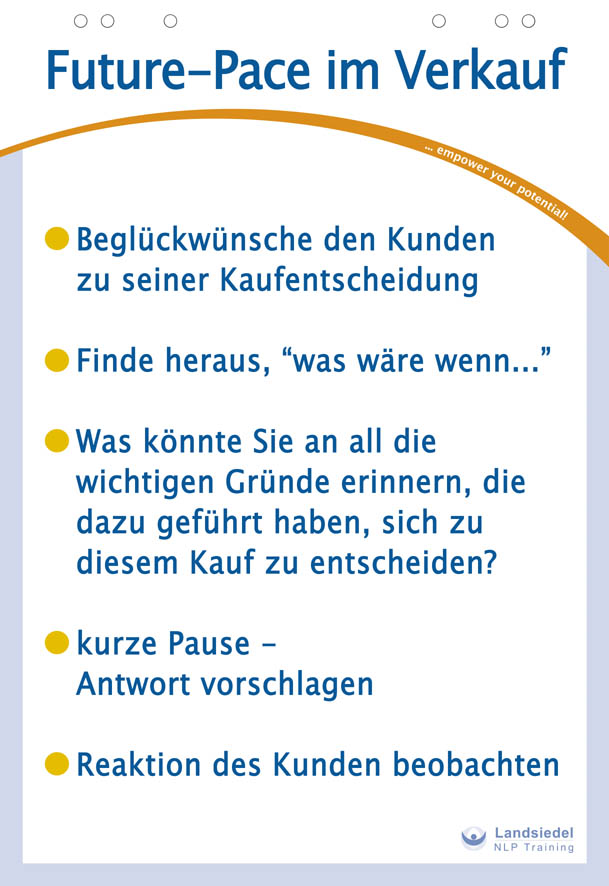Future Pace
This NLP technique allows you to carry the results of a change process into the future. Future Pacing serves to secure transfer and foster the real-life application of new behaviors.
Definitions of Future Pace / Future Pacing (bridging into the future):
From Ötsch & Stahl (“The Dictionary of NLP”)
1. First Definition
The process in which a person explores their future representations for a specific context, task, etc. Future Pacing is a standard NLP procedure at the end of change techniques.
Assume the issue was problem X (e.g., my behavior toward a colleague), and the technique related to situation Y (e.g., the weekly team meeting with this colleague). At the end of the NLP intervention, my future picture of Y is elicited: How do I now imagine the next meeting? What is there to see, hear, and feel? How do I perceive myself? What will I do, etc.? The representation developed here is regarded as a test for the quality and intensity of the intervention carried out.
A positive future representation after an NLP intervention is an indication that the desired change can occur naturally and automatically. A negative future representation indicates that the intervention used will have little effect on actual future behavior.
2. Second Definition
The term Future Pace is also used to mean a consciously constructed connection of a goal with the future (also called transfer). In contrast to the first meaning, this refers to the deliberate design of future images and their consolidation over time.
Future Pacing in this sense is often undertaken to place a learning experience into a future context and link it with future representations. The greatest enemy, one could say, is lack of recall: in everyday life we all too often forget our resources and our goals. Conscious Future Pacing is intended to ensure that the desired change appears not only in the consulting context but also in everyday life. Options include:
- Imagining the goal within concrete future situations
- Linking the goal to the inner timeline
- Asking for at least three concrete application possibilities for the abilities/behaviors contained in the goal
- Practicing the change as an internal strategy, defining now an external cue that will trigger recall of the goal
- Installing an inner instance (in the unconscious) that will automatically bring about the desired change
Future Pace after a Sale

-
Congratulate the customer on their purchase decision.
Capture their enthusiasm, amplify it, and share in it! Emphasize the truth: only the customer knows the reasons that led them to buy, and only they know how useful and advantageous this decision is for them. -
Find out “What if…”.
Try a typical scenario that could lead to backing out of the decision:
“What if …”, thereby placing your customer into a future situation in which their current resolve might waver. Check the two or three most important reasons for buyer’s remorse.
- “What if your spouse doesn’t support the decision?”
- “What if a family member or friend disapproves?”
- “What if you yourself start doubting your decision?”
-
While the customer considers these answers, ask:
“What could remind you of all the important reasons that led you to make this purchase?” This gives your customer a basis for developing their own strategy to address signs of doubt and ambivalence in the future. The question compels them to remember the considerations and excitement that led to the purchase decision. -
Pause briefly, then offer a suggested answer by linking doubts or criticism to recalling the reasons for buying.
“Sometimes the slightest hint of doubt is enough to re-trigger the excitement you’re feeling right now. Isn’t it reassuring to know that any doubts that might arise will immediately bring back all the reasons that led to this great decision? The doubt will only strengthen your resolve and certainty that you chose correctly, because only you truly know the reasons why you did the right thing.” -
Observe the customer’s reaction very carefully.
From their reaction you’ll recognize whether your Future Pace was successful. You’ll also notice that this method creates very strong rapport and further increases your customer’s enthusiasm.

 Deutsch
Deutsch English
English Français
Français 中文
中文 Español
Español नहीं
नहीं Русский
Русский